The Need
Studies in Alberta and Saskatchewan have shown potential for extracting lithium from brines in subsurface formations, which has led to significant investment and economic development with several projects and pilot projects underway. No such publicly available research had been conducted in NEBC despite similar, and in some respects more favourable, geologic conditions for lithium-enriched brines. Such foundational research was therefore required to facilitate investment decisions by industry, communities, and Indigenous groups.
Goals
This project fits under Geoscience BC’s Strategic Objective of ‘Identifying New Natural Resource Opportunities’ and our goal to:
- Improve cost competitiveness of the Montney Play through advanced science and innovative geoscience technologies.
Specifically, the goals for this project were to:
- Collect brine samples from prospective subsurface formations. Samples were collected from currently producing natural gas and oil operations. Data integrity was maintained through the collection and analysis of duplicate and blank (reference) samples as part of the program.
- Analyze brine samples for a full suite of physical and chemical parameters to produce a preliminary brine characterization dataset. Key analysis outputs are concentrations of lithium, boron, bromine and iodine as well as a full suite of other elements and water properties.
- Provide a high-level scoping economics evaluation.
- Create a favourability map for prospective formations based on formation flow rates and lithium concentrations to prioritize areas with lithium potential in NEBC.
Benefits
According to the World Bank’s Climate-Smart Mining: Minerals for Climate Action report, global production of metals such as lithium could grow by nearly 500% by 2050 to meet growing demand for clean energy technologies.
Lithium is included on the Government of Canada’s Critical Minerals List, which states that these minerals are “critical for the sustainable economic success of Canada and our allies and to position Canada as the leading mining nation as set out in the Canadian Minerals and Metals Plan”.
This project is the first public research to map lithium concentrations in NEBC. It is expected to attract significant new investment in the region and to help diversify the region’s economy. The project has also trained subject matter experts (SMEs) and highly qualified persons (HQPs).
This project created a legacy database of lithium, other elements, and water chemistry properties and concentrations in NEBC. The public, peer-reviewed results can help the natural resource sectors, governments, communities, Indigenous groups and academia further understand the potential for lithium extraction from brines in the region.
Project Advisory Committee
A volunteer Project Advisory Committee (PAC) advised and guided Geoscience BC and the research team. It oversaw the overall technical direction of the project and provided technical input to maximize the project’s technical value. Thank you to all PAC members for dedicating their time and expertise. Members of the PAC were:
- Daniel Alessi, University of Alberta (Chair)
- Sobhi Alhashwa, Ovintiv
- Colin Frostad, Tourmaline
- Erik Munson, Shell (Vice Chair)
Location Details
This project collected samples from 17 prospective subsurface formations using existing natural gas wells in NEBC, with a particular focus on wells within the Triassic Montney Formation. The research took place in the territories of Treaty 8 First Nations.
Geoscience BC encourages anyone planning mineral exploration work to first contact Indigenous groups in the area. The Province of British Columbia’s Consultative Areas Database can help with this (https://maps.gov.bc.ca/ess/hm/cadb/). The Association for Mineral Exploration (AME) also produces an Indigenous Engagement Guidebook.
What Was Found
This study was conducted over three phases: initial collection of brine samples from currently producing oil and gas operations; laboratory analysis of the samples for a full suite of physical and chemical parameters; and integration and reporting of the analyzed data with existing datasets, reservoir and physical geology, and published literature on the controls and distribution of lithium in brines.
Of the 133 initial samples collected, 95 were unique (the remainder were used for quality and assurance). These were supplemented with 229 samples from the Geological Survey of Canada. Data from a further 2,000+ samples from Alberta were also used. Analysis of the combined datasets aided in the understanding of lithium concentrations and controls by stratigraphic zones, lithology, geography and basin evolution.
Lithium concentrations exceeding 50 milligrams per litre (mg/L) are currently deemed economically interesting under current lithium extraction technologies. Within the Montney Formation, an in-situ lithium carbonate equivalent (LCE) resource of 9.8 million tonnes with an average concentration of 56 mg/L was estimated over an area of 32,000 km2.
The brine analyses found concentrations of lithium that ranged from negligible up to 100 mg/L. Approximately half of the samples were from the Upper and Upper Middle Montney units, with median values ranging from approximately 30 to 80 mg/L; these were the highest lithium concentrations found in the study area. The study noted that economic lithium extraction could be viable above 50 mg/L, and that although the Montney is not an aquifer, co-production of brines in association with natural gas production could be economic in some areas.
The study also provides information on lithium-enrichment models, as well as the use of widely available routine water analyses data as proxies for lithium concentration mapping. The study noted that, with the relatively few samples obtained, all formations in NEBC remain under-sampled, and that more brine sampling would help to better assess NEBC’s lithium potential.
Due to the unconventional and non-aquifer nature of the Montney reservoir, it is not economically and physically feasible to extract lithium from brines alone. However, there is the potential for lithium production to be associated with the anticipated continued natural gas development in NEBC. If the fluid production and fluid gathering systems resulting from such operations are sufficient and sustained, it may facilitate the development of direct lithium extraction technologies and infrastructure. Such a situation would reduce the risks associated with the long-term production needed to ensure a project is viable and existing fluid gathering systems would help to reduce project capital costs.

